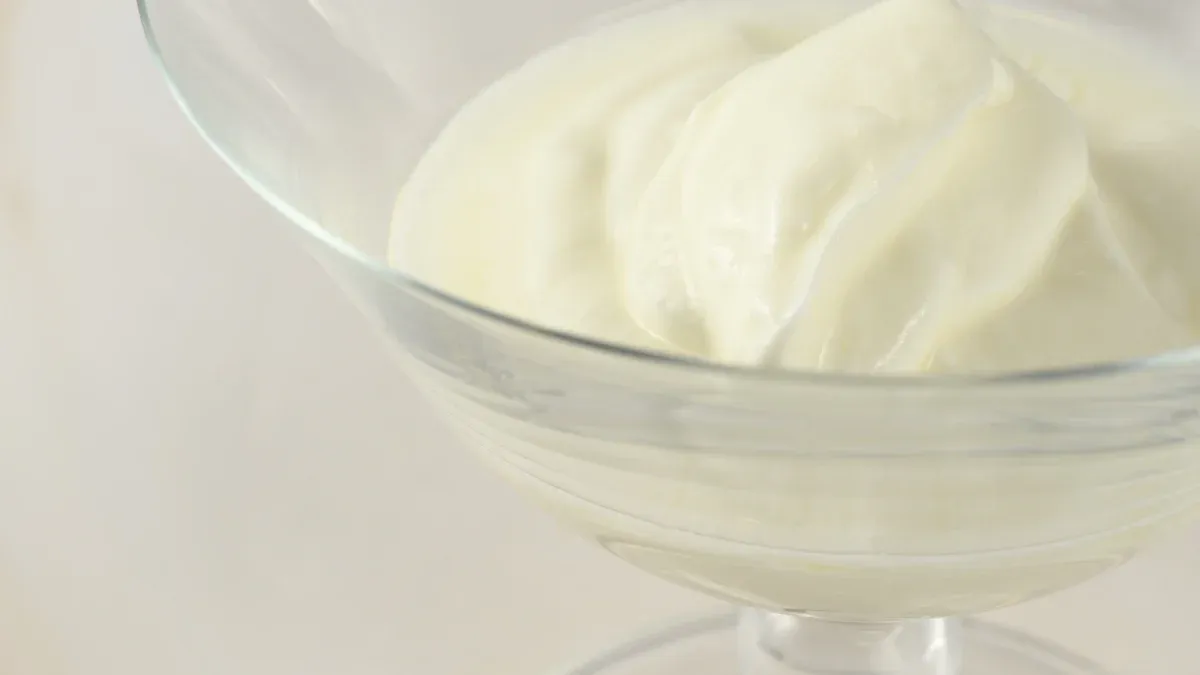
Mayonnaise uses many kinds of emulsifiers, like egg yolk, je suis de la lécithine, moutarde, soy milk, hydrocolloids, and pectin. These natural emulsifiers and synthetic emulsifiers help mix oil and water together. Each mayonnaise emulsifier changes how the mayonnaise feels, combien de temps ça dure, and how it tastes. Emulsifiers are important in old recipes, vegan recipes, and when making a lot of mayonnaise. The emulsification process lets food emulsifiers keep mayonnaise smooth and creamy. This process depends on the right mix of natural emulsifiers and synthetic emulsifiers, and also on which types of emulsifiers are used.
Principaux à retenir
Egg yolk is a great natural émulsifiant pour la mayonnaise. It makes mayonnaise creamy and stable. But some people are allergic to egg yolk. Plant-based emulsifiers like soy lecithin and soy milk are vegan choices. They may make mayonnaise less creamy and not last as long. Mustard gives mayonnaise more flavor. It also helps oil and water mix better. Hydrocolloids and pectin make mayonnaise thicker. They help it last longer by trapping oil drops. Picking the best emulsifier depends on taste and texture. It also depends on diet needs and how mayonnaise is made.
Mayonnaise Emulsifier Types
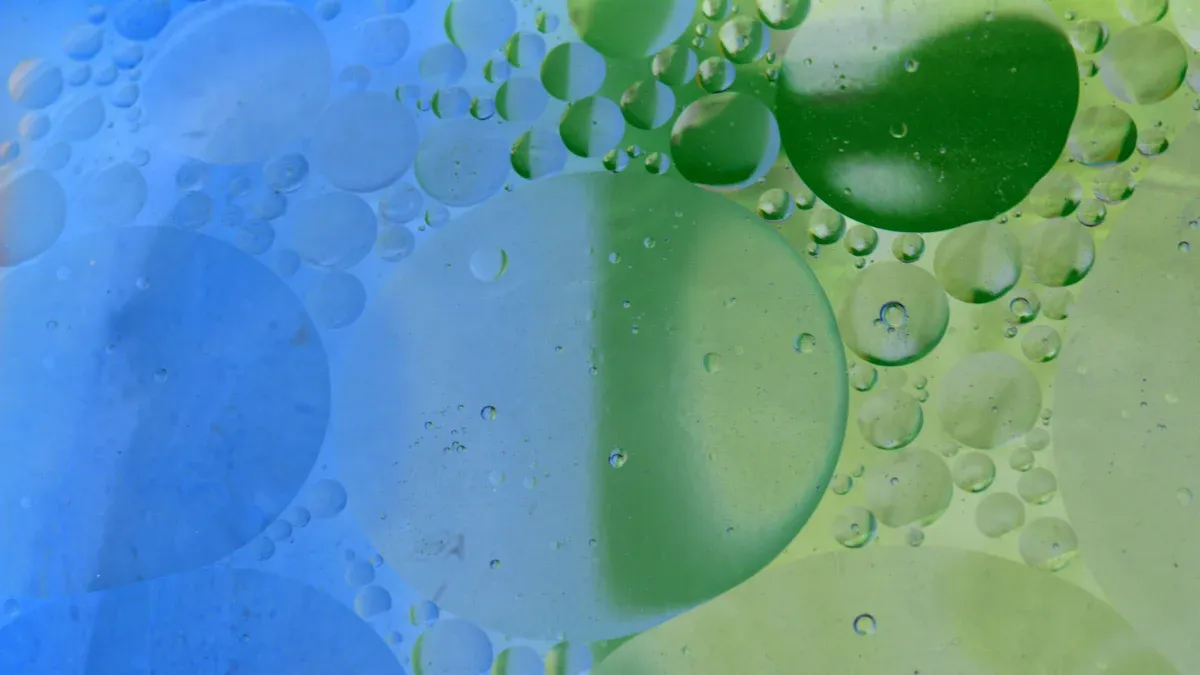
Jaune d'oeuf
Egg yolk is the main emulsifier in mayonnaise. It comes from chicken eggs. Egg yolk has proteins and phospholipids. These natural emulsifiers have parts that like water and parts that like oil. They make a layer around oil drops during the emulsification process. This layer keeps oil and water mixed together. It stops them from separating. Egg yolk still works well when things are acidic. This is important for mayonnaise. Maintenant, food emulsifiers from plants like soy and sunflower lecithin are made to act like egg yolk. These new types of emulsifiers use special mixing to make mayonnaise creamy and stable. Plant proteins like lupin, with citrus fiber or modified starch, can also take the place of egg yolk. These choices help people who want clean-label and vegan foods.
Soy Lecithin
Soy lecithin is a plant-based emulsifier for mayonnaise. It comes from soybeans. Soy lecithin has phospholipids that help mix oil and water. It is often used in vegan and factory-made mayonnaise. But it has less phosphatidylcholine than egg yolk. This makes it less stable and gives it a shorter shelf life. The table below shows the main phospholipids in soy lecithin and egg yolk lecithin:
Phospholipid Type | Soy Lecithin (%) | Egg Yolk Lecithin (%) |
|---|---|---|
Phosphatidylcholine (PC) | ~33 | 66-76 |
Phosphatidylethanolamine (PE) | 14.1 | 15-24 |
Phosphatidylserine (PS) | 0.4 | 1 |
Phosphatidylinositol (PI) | 16.8 | N / A |
Phosphatidic acid (PA) | 6.4 | N / A |
Lyso-phosphatidylcholine (LPC) | 0.9 | 3-6 |
Lyso-phosphatidylethanolamine (LPE) | 0.2 | 3-6 |
Sphingomyelin (SPM) | N / A | 3-6 |
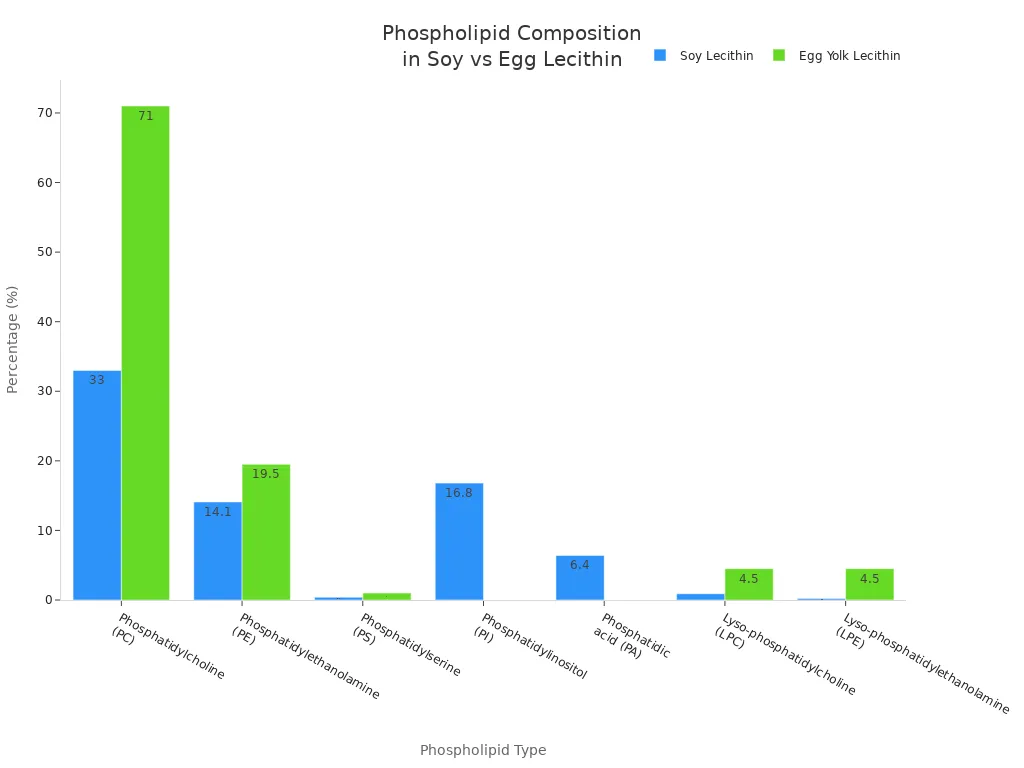
Soy lecithin is cheap and used a lot. But egg yolk lecithin gives better stability and more nutrition.
Moutarde
Moutarde gives flavor and acts as a natural emulsifier in mayonnaise. It has isothiocyanates that make mustard taste sharp. These also help keep the emulsion stable. Mustard is mixed with eggs and vinegar before adding oil. This step helps make a strong network of oil drops. Mustard makes mayonnaise more stable and stops it from separating. New knowledge about the emulsification process has made mayonnaise last longer and stay stable.
Soy Milk
Soy milk is a plant-based choice for vegan mayonnaise. Its proteins act as food emulsifiers. They make a layer around oil drops. This keeps oil and water mixed. Studies show that using up to half soy milk instead of egg keeps mayonnaise stable and tasty. The texture and look stay close to regular mayonnaise. If all the egg is replaced with soy milk, the emulsion is less stable and may separate later. Soy milk lets people have vegan and allergen-free mayonnaise that still tastes good.
Hydrocolloids and Pectin
Hydrocolloids and pectin are emulsifiers used in low-calorie or plant-based mayonnaise. These synthetic emulsifiers and natural emulsifiers make a network that traps oil drops. They give steric stabilization and lower friction. This makes mayonnaise smoother and creamier. The table below compares their properties to egg-based emulsifiers:
Functional Property | Hydrocolloids and Pectin-like Polysaccharides | Traditional Egg-based Emulsifiers |
|---|---|---|
Emulsification Mechanism | Steric stabilization, surfactant action | Protein and phospholipid film |
Droplet Size in Emulsion | < 3.0 μm | N / A |
Sensory Attributes | Increased creaminess, smoothness | Higher friction |
Physical and Thermal Stability | Higher stability in HIPEs | Lower stability |
Digestible Fat Content | À propos 1/12 of traditional | Plus haut |
Pertinence | Low-calorie, plant-based | Animal-based |
Hydrocolloids and pectin are good for people who want plant-based or low-calorie foods. They show how both natural emulsifiers and synthetic emulsifiers can make mayonnaise better today.
Emulsifier Performance
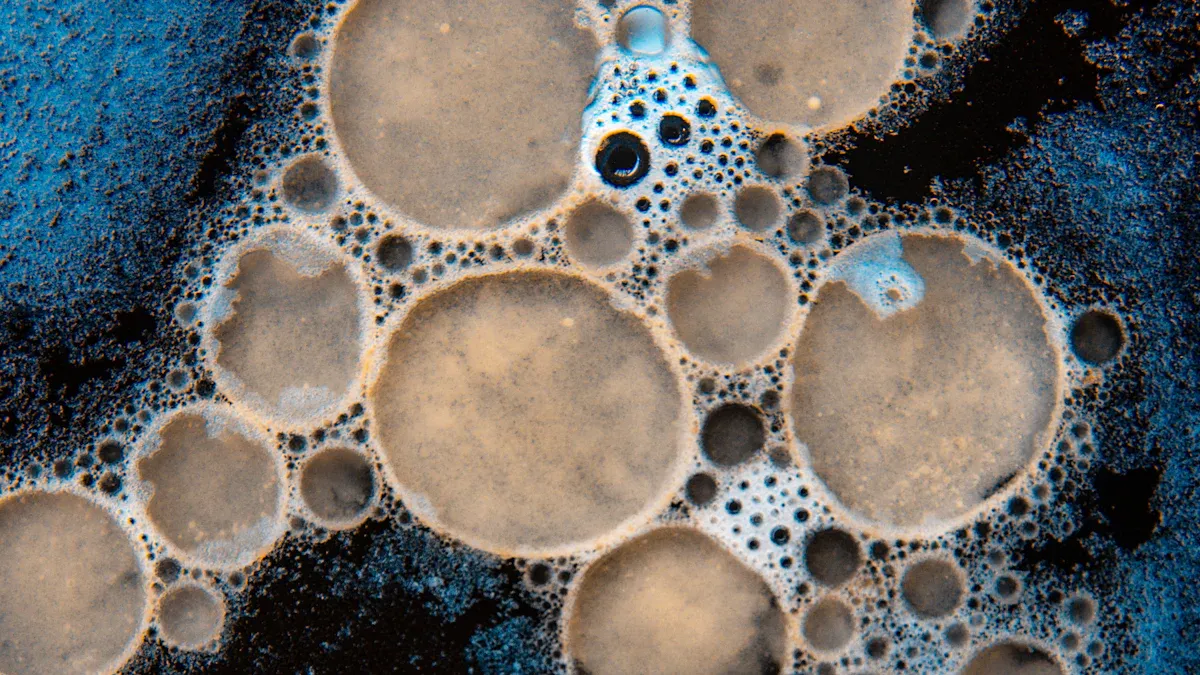
Emulsification Efficiency
Mayonnaise émulsifiant work in different ways to mix oil and water. Egg yolk does this job very well. Its proteins and phospholipids make a strong wall around oil drops. This wall keeps oil and water from splitting, even after a long time. Soy lecithin also helps keep mayonnaise mixed, but it has less phosphatidylcholine than egg yolk. Because of this, mayonnaise with soy lecithin may not stay mixed as long.
Mustard helps the oil drops stick together better. This makes the mixture stronger and less likely to separate. Soy milk proteins can mix oil and water well, but if you use only soy milk and no egg yolk, the mayonnaise is not as stable. Hydrocolloids and pectin, which can be natural or synthetic emulsifiers, make mayonnaise thicker and form gels. These gels trap oil drops and stop them from separating during storage.
Hydrocolloids and pectin help mayonnaise stay mixed by making it thicker and forming gels that keep oil and water together, even after a long time.
Texture and Mouthfeel
The kind of emulsifier changes how mayonnaise feels and tastes in your mouth. Egg yolk makes mayonnaise creamy and rich. It gives a smooth feeling that many people like. Soy lecithin makes mayonnaise lighter, which some people may not enjoy as much. Mustard makes mayonnaise a little thicker and gives it a special feel.
Hydrocolloids and pectin make mayonnaise thicker and creamier. They make it smoother by lowering friction between oil drops. This helps mayonnaise stay stable and nice to eat. If you use some soy milk instead of egg yolk, the texture is close to regular mayonnaise. But if you use only soy milk, mayonnaise can feel thinner and less creamy.
A table below shows how different mayonnaise types change in texture:
Mayonnaise Type | Émulsifiant / Oil Phase | Texture & Physicochemical Changes |
|---|---|---|
M-CO (Corn Oil) | Egg yolk | Softest and least chewy; oil drops are less packed |
Egg yolk oil | Hardest and chewiest; oil drops are packed tightly; color is more golden | |
M-DE (Salted Duck Egg Yolk Oil) | Egg yolk oil variant | Thicker and oil drops are smaller |
M-FE (Fresh Egg Yolk Oil) | Egg yolk oil variant | Thicker and oil drops are smaller |
Flavor Impact
The emulsifier you pick changes how mayonnaise tastes. Egg yolk gives mayonnaise a rich and savory flavor. It also helps make new flavors when used with different oils. Par exemple, using salted egg yolk oil makes mayonnaise taste special and richer. People who like salted egg yolk flavors often enjoy this kind of mayonnaise.
Mustard gives mayonnaise a sharp and tangy taste. It can hide some of the egg flavor and make the taste more interesting. Soy lecithin and soy milk have mild flavors. They let other flavors stand out but do not add much taste themselves. Hydrocolloids and pectin do not change the flavor much. They let the main ingredients be the focus.
Mayonnaise Type | Émulsifiant / Oil Phase | Flavor Profile Impact | Consumer Preference Insights |
|---|---|---|---|
M-CO (Corn Oil) | Egg yolk | A 9 special flavor compounds; basic taste | Used as a basic example |
M-HE (Salted Hen Egg Yolk Oil) | Egg yolk oil | Special aroma and richer taste | More popular in salted egg yolk markets |
M-DE (Salted Duck Egg Yolk Oil) | Egg yolk oil variant | Different taste | No clear data |
M-FE (Fresh Egg Yolk Oil) | Egg yolk oil variant | Different taste | No clear data |
Shelf Life and Stability
How long mayonnaise lasts and stays mixed is very important. Egg yolk keeps mayonnaise stable, even when it is sour. Soy lecithin gives some stability, but mayonnaise may not last as long as with egg yolk. Mustard helps stop the oil and water from splitting and makes mayonnaise last longer.
Hydrocolloids and pectin are very good at stopping oil and water from separating during storage.
Hydrocolloids keep mayonnaise mixed for a long time.
They make mayonnaise thicker and form gels, so it stays creamy.
Pectin is a kind of hydrocolloid that forms gels and makes mayonnaise thicker, helping it stay mixed.
These ingredients also lower water activity, which slows spoilage and helps mayonnaise last longer.
Hydrocolloids work well in many recipes because they handle different pH and salt levels.
Dietary and Allergen Suitability
People with food allergies or special diets need to pick their mayonnaise emulsifier carefully.
Plant-based emulsifiers like soy lecithin, pea protein, and saponins are good for vegan, egg-free, and allergen-free diets.
These emulsifiers do not have common animal allergens like egg proteins.
Saponins from plants help keep mayonnaise stable in many situations.
Food safety rules say that allergens like egg and soy must be listed on labels. Companies must follow these rules to keep people safe.
The FDA says most plant-based emulsifiers are safe, but companies must check labels and make sure ingredients work together.
The table below shows which ingredients can cause allergies and how companies handle them:
Allergenic Ingredient | Allergenic Proteins / Composants | Allergenic Risk Details | Management in Commercial Products |
|---|---|---|---|
Egg yolk | Lécithine, livetin, vitellin | Egg is a common allergen and can cause bad reactions | FDA says labels must be clear; people should read labels and ask doctors |
Soy lecithin / Soybean oil | Soy proteins (less in refined oils) | Soy allergy is common; some oils still have proteins | Labels are important; people with soy allergy should avoid some oils |
je suis du lait | Soy proteins | Soy allergy is common; soy milk has allergenic proteins | People with soy allergy should avoid it; read labels and ask doctors |
Conseil: If you have egg or soy allergies, always read mayonnaise labels and talk to your doctor before trying new products.
Choosing the Right Mayonnaise Emulsifier
Traditional Mayonnaise
Traditional mayonnaise uses egg yolk as the main emulsifier. Egg yolk has lecithin, which helps oil and water mix. Most places use egg yolk, but the oil and acid can change the taste. In the United States, people often use soybean oil. In Europe, they might use rapeseed or sunflower oil. Some places add mustard for more flavor and to help keep it mixed. The table below lists important things about traditional mayonnaise:
Factor/Aspect | Description/Details | Regional Variations/Examples |
|---|---|---|
Émulsifiant | Egg yolk is the main emulsifier because of lecithin. It keeps oil and water together. | Used in traditional recipes everywhere. |
Conditions de traitement | Temperature and mixing speed are important. Cold process is below 5°C. Hot process is about 70°C. How fast you add oil matters too. | These steps help keep mayonnaise stable and good. |
Oil Type | Most use vegetable oils. The kind depends on what is easy to get. | US uses soybean oil. Canada and Europe use rapeseed, sunflower, or corn oil. |
Acidifying Agent | Vinegar or lemon juice changes the taste and helps keep it safe. | Europe likes a sour taste. Northern Europe likes it sweeter and with mustard. |
Additional Emulsifiers/Flavor | Mustard is often added for taste and to help mix. | Many places use mustard, especially in northern Europe. |
Emerging Trends | More people use plant-based emulsifiers and egg replacements. These include vegetable proteins and gums. | These are used more in new and vegan mayonnaise. |
Fat Content | Mayonnaise usually has 65-80% huile. You need the right amount of oil for each egg yolk. | This is about the same everywhere, but some places change it a little. |
Note: Egg yolk is still the best for traditional mayonnaise, but more people are trying plant-based and natural emulsifiers.
Vegan and Allergen-Free Options
Vegan mayonnaise uses plant-based emulsifiers instead of egg yolk. Aquafaba, which is the liquid from cooked chickpeas, is a popular choice. When mixed with peanut sprout oil, aquafaba makes mayonnaise that is firm, écurie, and tastes good. Many people cannot tell aquafaba mayonnaise from regular mayonnaise. The small oil drops in aquafaba mayonnaise help make it creamy and stable.
Allergen-free mayonnaise has special problems. Without egg yolk, it loses a strong emulsifier. Egg yolk can also cause allergies, high cholesterol, and sometimes food poisoning. Food makers try different things:
They use plant proteins, but these may not have all the needed amino acids or may be hard to digest.
Some try proteins from edible insects, like mealworm larvae. These proteins work well as emulsifiers, have good nutrition, and are better for the environment.
Other choices are protein hydrolysates and starch-based emulsifiers.
Conseil: Food companies keep testing new natural emulsifiers and insect proteins, but replacing egg yolk fully is still being studied.
Industrial vs. Homemade Use
Factories making mayonnaise need emulsifiers that work in big batches and last during shipping and storage. They often use both natural and synthetic emulsifiers to get the right texture and shelf life. Hydrocolloids and pectin help mayonnaise stay thick and creamy for a long time. These ingredients also help keep costs down and follow food safety rules.
Homemade mayonnaise usually uses egg yolk and sometimes mustard. People at home can pick their own ingredients and skip synthetic emulsifiers. They often choose natural emulsifiers for a fresher taste and simple label. Homemade mayonnaise does not last as long as store-bought, but you can control the flavor and texture.
Homemade mayonnaise lets you pick your favorite oils and flavors. Factories focus on making mayonnaise that is safe and stable for many people.
Every mayonnaise emulsifier has its own good points. Egg yolk makes mayonnaise thick and smooth, but it can cause allergies. Soy lecithin and soy milk are good for vegans, but they might make mayonnaise less creamy. Hydrocolloids and pectin help mayonnaise last longer and are used in big factories. If you want the classic taste, egg yolk is still the best. Vegan and allergen-free mayonnaise now use plant proteins, aquafaba, et Opuntia mucilage.
Some new ideas are:
Using vegetable leftovers to change texture
Green ingredients like nanocellulose
Picking the right emulsifier helps mayonnaise taste good, feel right, and fit different diets.
FAQ
What is the main job of an emulsifier in mayonnaise?
Un émulsifiant lets oil and water mix. It keeps mayonnaise smooth and stops it from splitting. Egg yolk, je suis de la lécithine, and mustard are all used as emulsifiers in mayonnaise.
Can people with egg allergies eat mayonnaise?
People who are allergic to eggs should not eat mayonnaise with egg yolk. They can pick vegan mayonnaise made with soy lecithin, soy milk, or hydrocolloids. Always look at the label to check for allergens.
Does vegan mayonnaise taste the same as regular mayonnaise?
Vegan mayonnaise usually tastes a lot like regular mayonnaise. Some people think it feels lighter or tastes less strong. The emulsifier, like soy milk or aquafaba, can change how it tastes and feels.
How do hydrocolloids help mayonnaise last longer?
Hydrocolloids make mayonnaise thicker and form gels. These gels hold oil drops and keep the mixture together. This helps mayonnaise stay creamy and fresh for more time.
Which emulsifier is best for homemade mayonnaise?
Egg yolk is the best for homemade mayonnaise. It gives a rich taste and creamy feel. If you want a plant-based choice, you can use soy milk or aquafaba.
Conseil: Always pick fresh ingredients to make the best homemade mayonnaise!
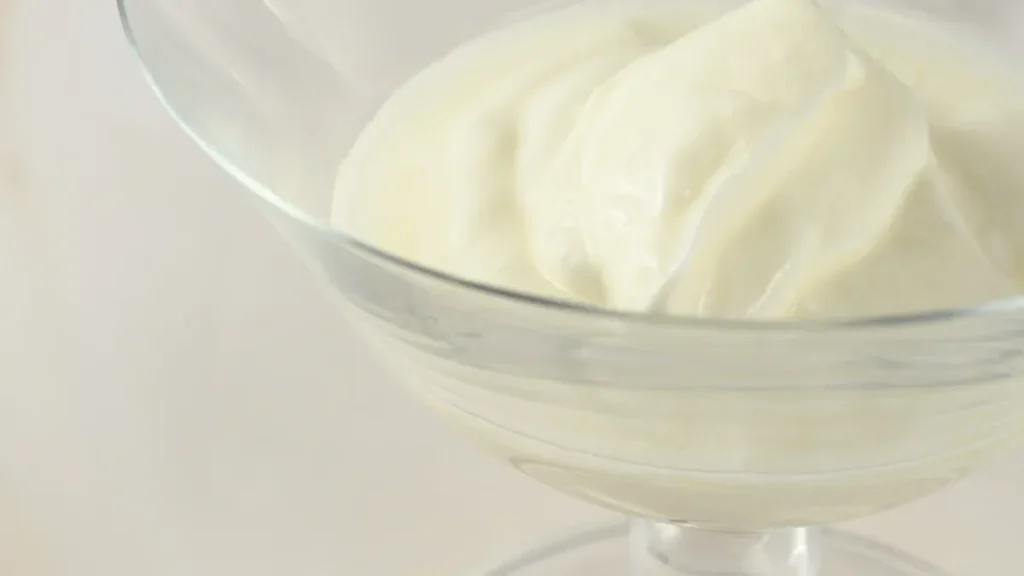

Yo! 755bet5, eh? Another one to add to the list! Hope it’s not just another flash in the pan. Time to put it to the test. Give it a shot here: 755bet5